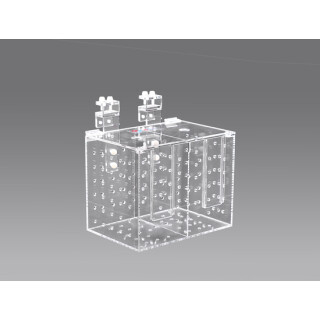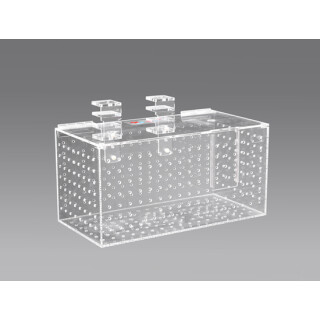Guide to the acclimatization of marine fish and invertebrates
Guide to the acclimatization of marine fish and invertebrates
Please read these instructions carefully before opening the transport bag(s), improper acclimatization can lead to the death of animals!
General information:
The composition of seawater in each aquarium is different and marine animals such as fish, shrimp, crabs, anemones, etc. do not tolerate rapid changes in water
parameters well. In addition, some parameters, such as the pH value, change significantly during transport lasting several hours due to exhalation and excretion.
By slowly adapting the transport water to your aquarium water, you help the animals to acclimate well and prevent losses due to moving too quickly, t<
oo slowly or even directly.
Extensive feeding of the old stock before introducing new fish can be very helpful, full fish are less aggressive and will attack newcomers less vehemently.
Another helpful means against aggression are "swimming schools", small acrylic containers with which fish can be temporarily hung in the aquarium after they have
been adjusted, but are protected against possible attacks by the old stock.
First of all, look carefully at the animal or animals in the transport bag before you start to acclimate it or before you open the transport bag(s).
If you realize that an animal has problems but is still alive, be sure to leave the bag closed and contact us immediately by phone at 07123-3077460
If an animal is dead, please refer to the information sheet on “Complaint processing for dead animals” enclosed with each shipment.
Unfortunately, we cannot accept late or insufficiently illustrated complaints!
Always keep dead animals until the complaint has been processed (e.g. in the freezer),
we reserve the right to collect dead animals at our expense.
- Step 1: Open the transport bag and check the salinity and temperature of the transport water and compare them with the values in your aquarium. The further apart the values are, the more careful you have to acclimate the animals. After completion of the acclimatization or before the animals are introduced, the values in the acclimatization tank should be approximately the same as in the aquarium.
- Step 2: Ideally, carry out the acclimatization in separate, clean containers such as small buckets or similar, but you can also acclimate the animal/animals in the opened transport bags. Now pour off approx. 25-50% of the transport water, but there should always be enough water in the acclimatization container to ensure the freedom of movement of the animals!
- Step 3: Now start to gradually replace the transport water with your aquarium water, this process should not take longer than 30-45 minutes in total. To do this, you can either add aquarium water drop by drop to the container using a small hose with an adjustable tap, or you can add small amounts of water from your aquarium by hand every minute.
- Step 4: After approx. 5 minutes, pour out approx. 20% of the water from the acclimatization tank again and then continue as described in step 3. Repeat this adding and draining of water for about 30 minutes until the salinity and temperature in the acclimatization tank and aquarium are approximately equal. The drained transport water should not be put into the aquarium! Replace the acclimatization seawater from your aquarium with fresh seawater to restore your aquarium to the correct salinity.
- Step 5: Now carefully place the animal/animals in your aquarium. To do this, pour off most of the water from the acclimatization tank and ideally let the fish slide into the aquarium. Alternatively, use a bell or net, but be aware that some fish have spines or skin protrusions that can snag nets. In addition, in the event of direct contact (e.g. with a net), injuries to the eyes and the sensitive mucous membranes of fish can never be ruled out. Sea urchins, starfish, tube worms and sponges must be moved underwater, these animals are not allowed to come out into the air.
- Step 6: Watch new fish carefully to see if there are any disputes with other aquarium inhabitants and, if necessary, dim the lighting down or switch it off completely. In this way, newcomers can first fully acclimate without being attacked by the long-established animals. Feed new animals as quickly as possible. Snails should always be used in the right direction to protect them from attacks by other animals such as hermit crabs, shrimp, but also various fish. Some snails, such as Nerita species, cannot turn themselves!
If you follow all of these tips, you will help your new protégés to get off to a good start in their new aquarium home.
We hope you enjoy your new animals!
Your "Coral Outlet" team
(translated with Google translator)
In stock

- 5 set In stock
-
Delivery time: 1 - 3 Workdays (DE - int. shipments may differ)
17,50 € *
In stock

- 6 piece In stock
-
Delivery time: 1 - 3 Workdays (DE - int. shipments may differ)
49,90 € *
In stock

- 2 piece In stock
-
Delivery time: 1 - 3 Workdays (DE - int. shipments may differ)
107,90 € *
In stock

- 4 piece In stock
-
Delivery time: 1 - 3 Workdays (DE - int. shipments may differ)
21,95 € *

